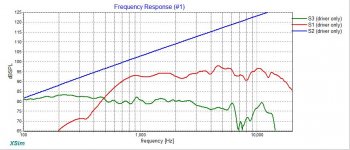Your midrange branch circuit is incorrect. L3 and C3 should be connected like those elements were in the first diagram.
3 AM here, so I'm off to bed. Sorry to bail on you.
3 AM here, so I'm off to bed. Sorry to bail on you.
re:'Not too sure on the baffle width' - the crossover design would be easier for you if your lower crossover point was at the baffle step frequency
Just looked at the drivers, It would make more sense to use the same wavecor driver as both your mid and woofer, this would simplify the sensitivity matching,
better overall sensitivity and probably give a better result than the Dayton
Just looked at the drivers, It would make more sense to use the same wavecor driver as both your mid and woofer, this would simplify the sensitivity matching,
better overall sensitivity and probably give a better result than the Dayton
Last edited:
Hi, I've seen this statement before but never understood the principle. Could someone elaborate or illustrate why this is the case?re:'Not too sure on the baffle width' - the crossover design would be easier for you if your lower crossover point was at the baffle step frequency
Say you have a baffle width of 14", so f3 = 4560 / 14 = 325hz.
Assuming an LR2 low pass on the bass driver and LR2 high pass for the midrange, with 90db system target, does crossing at 325hz change the bass unit's target LP slope or the attenuation and HP slope of the midrange, or something else?
Thanks.
Last edited:
Thank you. Does this look better?Your midrange branch circuit is incorrect. L3 and C3 should be connected like those elements were in the first diagram.
3 AM here, so I'm off to bed. Sorry to bail on you.
I think the tweeter is the main problem for sensitivity matching. Also, the wavecores can not reach lower frequencies.re:'Not too sure on the baffle width' - the crossover design would be easier for you if your lower crossover point was at the baffle step frequency
Just looked at the drivers, It would make more sense to use the same wavecor driver as both your mid and woofer, this would simplify the sensitivity matching,
better overall sensitivity and probably give a better result than the Dayton
Please reduce the drive voltage to 2.83 V, and turn on the S1, S2, and S3 frequency response curves.
Also add R1 back into the tweeter circuit and set the value to 6 ohms.
Also add R1 back into the tweeter circuit and set the value to 6 ohms.
Ok I will try to fix.As mentioned earlier by AllenB, there's something wrong with your midrange driver's file. The output is way too high to be believable, and the shape of the frequency response is unlikely as well.
Greets!Hi, I've seen this statement before but never understood the principle. Could someone elaborate or illustrate why this is the case?
Say you have a baffle width of 14", so f3 = 4560 / 14 = 325hz.
'Sound is round' as one DIYer opined long ago, so visualize a ~hemisphere (2pi/half space) ~setting on the baffle at ~325 Hz (actually more like 160 deg than 180) and it's rapidly expanding exponentially with decreasing frequency, so more n' more of the sound power is falling back/around the speaker as it plays lower.
As mentioned earlier by AllenB, there's something wrong with your midrange driver's file. The output is way too high to be believable, and the shape of the frequency response is unlikely as well.
Does this look right?
Attachments
Thanks - I understand the phenomenon of the baffle step - my question is why crossing at the F3 is sometimes recommended to address it.Greets!
'Sound is round' as one DIYer opined long ago, so visualize a ~hemisphere (2pi/half space) ~setting on the baffle at ~325 Hz (actually more like 160 deg than 180) and it's rapidly expanding exponentially with decreasing frequency, so more n' more of the sound power is falling back/around the speaker as it plays lower.
re:'why crossing at the F3 is sometimes recommended' - Not the F3, the baffle step frequency. Doing this you can deal with Baffle step compensation by using the difference between mid & woofer sensitivities rather than adding extra compensation circuitry. i.e. making the woofer ~3db more sensitive than the mid usually works well
There's still a weird peak in the midrange frequency response.
Mute S1 and S3. Short C2 and L2. Open L3 and C3. This should give you the frequency response of the midrange only with no crossover. Please post that plot.
Mute S1 and S3. Short C2 and L2. Open L3 and C3. This should give you the frequency response of the midrange only with no crossover. Please post that plot.
- Home
- Loudspeakers
- Multi-Way
- Crossover Design Help

